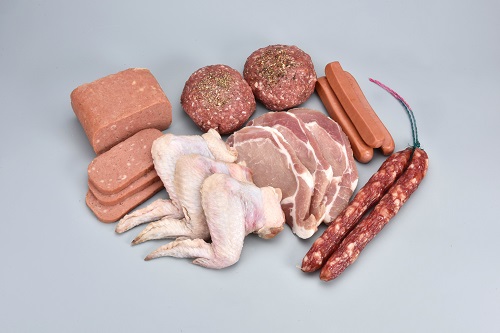
Food Safety Focus (129th Issue, April 2017 ) – Food Safety Platform
The Use of Food Additives in Meats
Reported by Ms. Michelle CHAN, Scientific Officer,
Risk Assessment Section,
Centre for Food Safety
Meat is a source of protein, vitamins and minerals. It can be used to prepare different meat dishes and processed meat products. To improve food safety and quality, food additives had been safely used in meat processing for long time. But some consumers still have concerns over the use of food additives. In this article, we will introduce the application, safety and regulation of certain food additives in meats.

What are Food Additives?
Generally speaking, food additives are substances intentionally added to food to serve certain technological functions, such as to improve taste, appearance, texture or stability, and to prolong shelf life of foods.
Why Food Additives are Used in Meats?
Meat is a perishable commodity. If it is not kept properly, it may support growth of microorganisms such as bacteria, yeasts and moulds which can spoil the meat and, even worse, produce toxins. Meat is also susceptible to fat oxidation and may become rancid with off-flavour. In order to extend the shelf life of meat and reduce wastage, preservatives are added as antimicrobials to prevent or retard the growth of microorganisms whereas antioxidants are used to act against deterioration of meat due to oxidation.
Meanwhile, other additives may be applied in meats to improve sensory quality, e.g. flavour enhancer to intensify meat flavour or stabiliser to enhance texture of meat products.
Food Additives that may be Added to Meats
Phosphates have wide application in meat processing. They can retard microbial growth and reduce rancidity in meat. In addition, phosphates increase the water-holding capacity of meats making them juicy and easily chewable. They also stabilise the texture of meat products like sausages by creating a strong muscle protein structure that hold the product together after heat treatment.
Sodium nitrite may be added in processed meat such as luncheon meat to serve various technological functions including impart heat resistant red colour and specific curing flavour which is attractive to some consumers, retard oxidative process and most importantly, inhibit growth of the bacterium, Clostridium botulinum. Spores produced by Clostridium botulinum exist widely in the environment, easily contaminate the meat and may grow and excrete neurotoxic botulinum toxin in the absence of oxygen. Consumption of improperly processed food contaminated with botulinum toxin can lead to life-threatening disease. Ingested nitrite, on the other hand, may be transformed to N-nitroso compounds in human digestive tract under certain conditions. N-nitroso compounds are probable carcinogens. In view that no alternatives have been identified to replace sodium nitrite for bringing the same multifunctional effects in processed meat, such effects are achieved with extremely small amount of nitrite, and that the advantages outweight the risks, sodium nitrite is allowed to be used in some types of processed meat at low levels across different countries/places.
General Principles for Using Food Additives
Overall speaking, the use of food additives is justified only when such use has an advantage or serves particular technological function(s). More importantly, it should not present an appreciable health risk to consumers at the intented level of use and their uses should not mislead consumers. For example, sulphur dioxide, a common preservative in many foods, is prohibited to be added to fresh meat as it can delay oxidative process that keeps the desirable fresh meat colour (purplish-red or cherry-red) from changing to brownish-red colour, giving consumers the false impression that the meat is still fresh.
Moreover, food additives should be used under conditions of Good Manufacturing Practice, when the amount added to food is limited to the lowest possible level necessary to accomplish the desired technological effect.
How are Relevant Food Additives Regulated in Hong Kong?
In Hong Kong, all foods for sale must be fit for human consumption. In the local legislation, the Preservatives in Food Regulation (Cap. 132BD) specifies the types of permitted preservatives and antioxidants and their respective maximum permitted levels in specified foods including meats.
Food trade should be aware that the use of food additives in meats may vary between countries/places. They must make sure that their products comply with relevant local regulations.
Make Informed Choices by Reading Food Labels
For consumers, they can make informed choices and check if food additives are present by reading the ingredient list on the food package.
All in all, in order to enjoy the benefits of consuming meat, it is always prudent to purchase meats from reliable shops, cook them thoroughly and consume in moderation as part of a balanced diet.


